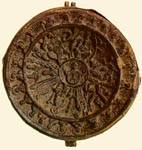|
|
| Byzantine Minor Arts |
13th-14th c. Chelandari Monastery Rhinoceros horn (?) with relief work and silver Diameter 11.5 cm Provincial workshop, possibly Serbian |
|

|
An encircling metal strip protects the edge of this shallow, flat-rimmed dish, which has been mounted on a base in the shape of a truncated cone connected with the metal rim by two metal bands laid cross-wise. This type of mounting was designed to enable the vessel to be set on the altar without concealing its exterior ornamentation: pairs of polyommata seraphim, their outstretched hands holding aloft three flaming torches, alternate in the triangular compartments framed by the silver strapping of the mount with pairs of interlocking wheels. The carefully crafted low relief work permits a gentle differentiation of volumes and planes. The decoration of the interior of the dish is divided into three discrete zones. Within a raised frame in the centre of the panagiarion is a medallion with a bust of the Virgin in the type of Vlachernitissa (Kondakov 1914-15, II, pp. 55 ff.), the folds of her mantle partially replacing the aureola which usually encircles the figure of the Christ Child. Opposite one another in the second zone are the figures of the Virgin enthroned, surrounded by full-length adoring archangels, and of the Holy Trinity (the Father enthroned, with the Son seated in front of him, holding the Dove), flanked by six-winged cherubim and busts of angels and prophets. In the outer zone, the bust of Christ, aligned with the Trinity and the Vlachernitissa, is flanked by the figures of the Virgin and John the Baptist, and beyond them seventeen busts of archangels, apostles and hierarchs, identified by the incised initials of their names. According to Radojcic (1955 (1), p. 184 n. 14), the very material of which the panagiarion is made has a symbolic value, being associated with the 'unicorn' and thus with the Incarnation. The concept of the Incarnation, in fact, dominates the entire iconographic composition, as it does in the Xeropotamou (no. 9.5) and Panteleimon panagiaria. Iconographically, the decoration seems to be associated with certain Old Slavonic texts. The same anthropomorphic representation of the Holy Trinity, however, is found in a manuscript from the eleventh or twelfth century and in thirteenth-century frescoes and manuscripts (Mavropoulou-Tsioumi 1973, pp. 85-9). While stylistically the carving of the panagiarion may belong to the Palaeologan period, with certain vaguely Western touches, its quality and iconography attest to provincial workshop, possibly Serbian (Bogdanovic - Djuric - Medakovic 1978, p. 58).
| |
|
Bibliography: Radojcic 1955 (1), p. 193. Bogdanovic - Djuric - Medakovic 1978, p. 58, fig. 35.
| ||
| K. L-T. | ||
| Index of exhibits of Monastery of Chelandari 13th century |
||
Reference address : https://www.elpenor.org/athos/en/e218ci17.asp